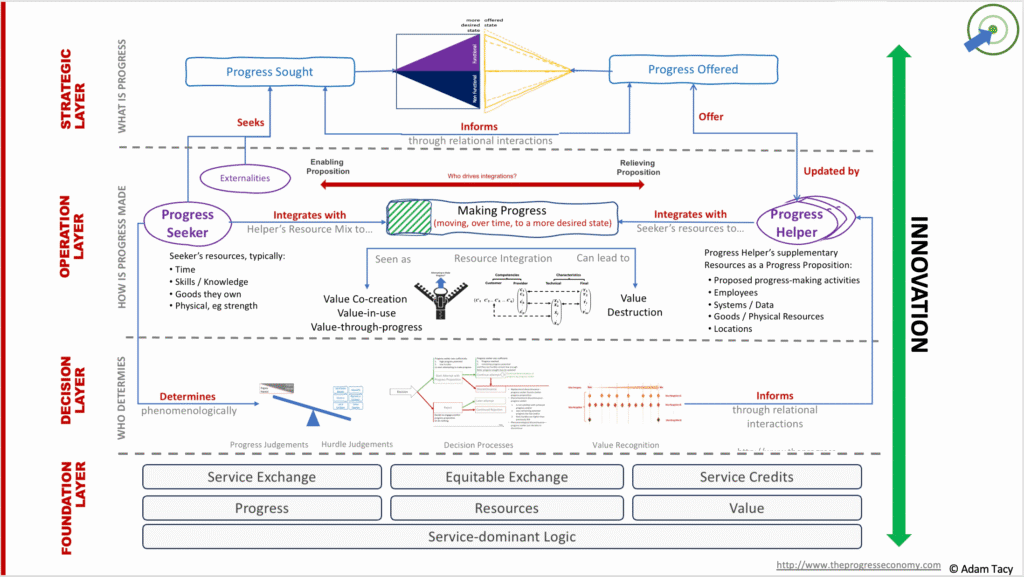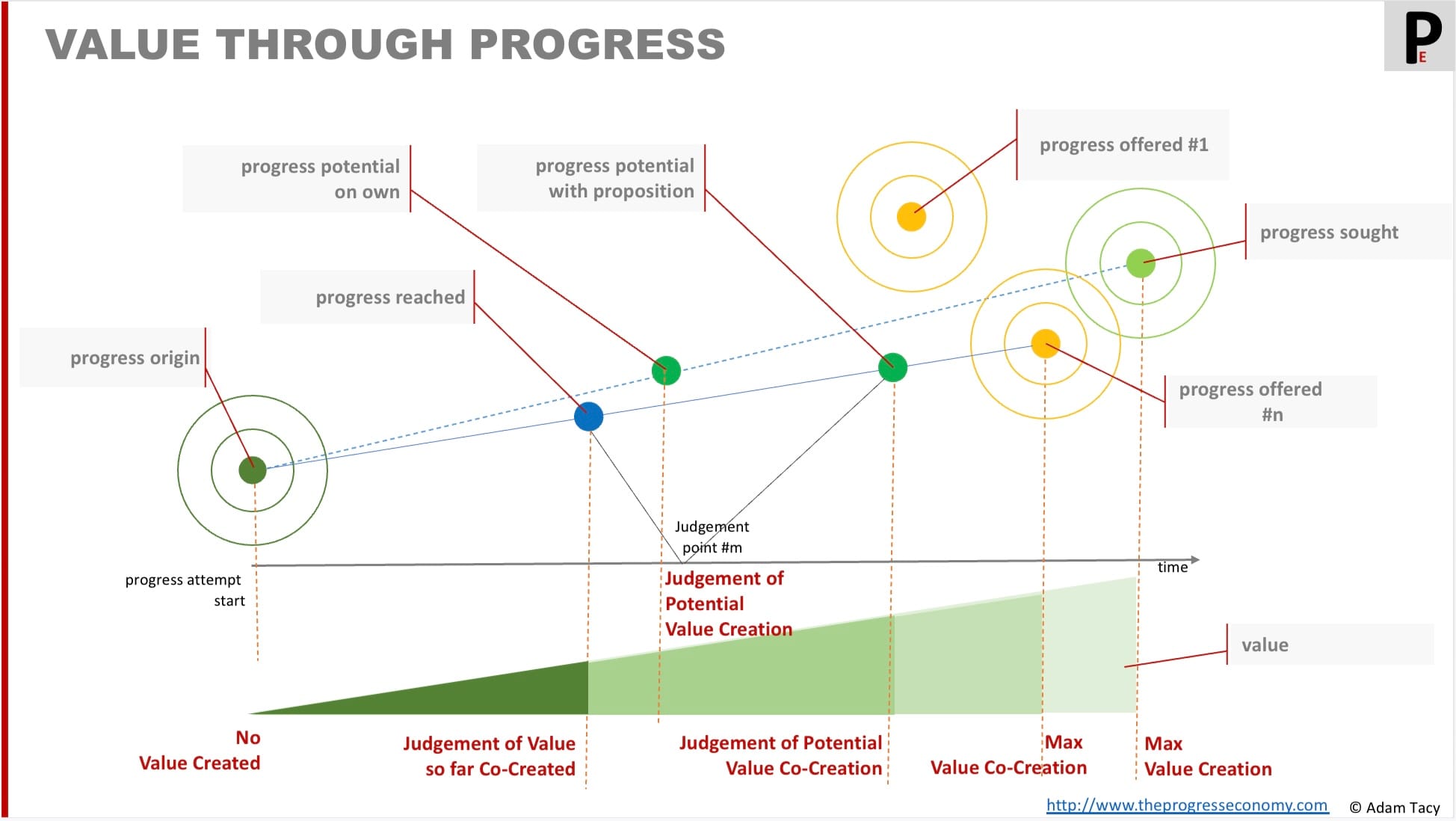The model’s benefits
That’s been quite a ride! Let’s regroup around the benefits the value-through-progress model brings over value-in-use. Our benefits are from:
- building upon value-in-use / service-forward logics giving us all their benefits
- defining actionable definition of progress and thereby value
- understanding market-fit and gaps
- constructing a 4-layer operating system for progress/value
- rebalancing the continuum
- appreciating other actors view of value
- explaining the market
- restoring a link to price – business model innovation
Interestingly, we can now look back at value-in-exchange from our new perspective.We observe it as a collapsing of this complexity for the sake of simplicity and management. From a marketing perspective, subjectivity becomes objectivity (price), and the comparison is simplified to whether the product meets needs (an often incomplete view of progress offered and progress sought). As we have seen, this approach has been successful for centuries, but now we’re facing challenges in growth and innovation due to its blind spots. It’s time to deal with our more complex model.
building upon value-in-use – inheriting benefits
Remember how we saw value-in-use provides solutions to the growth/innovation constraints of value-in-use? Although it had its own constraints. Here they are again as it’s been a while since we looked at them:
benefits of value-in-use
- focussing on true determinator of value
- seeing opportunities before, after, and across the point of exchange
- harnessing the circular economy
- leveraging the sharing economy
- freeing us from the the constraining IHIP/5Is view of services
- enabling or relieving the beneficiary, or somewhere in-between
- seeing a wider solution space
- seeing a system of propositions
- seeing a wider business model space
constraints of value-in-use
- defining value (well-being) remains challenging
- lacking clear mechanisms for value creation
- constraining definition of service
- only the beneficiary determines value
- lose actionable definition of price
- moving to direct service is all consuming
By building value-through-progress on top of value-in-use we inherit all the benefits. We then set about addressing the constraints. Starting with developing better definitions.
defining actionable definitions
as a state covering 3 elements: functional, non-functional and contextual. From which we can
clearly identify start and end points as well as judgements – progress as noun)understand progress between states as a verb or as state transition
Jumping ahead a little, we can take the concept established here and build out a hierarchy of contexts.

We have:
- value and progress – value as we’ve discussed here, and progress as we discuss more here
- progress attempts – using seeker’s resources and discovering the lack of resource hurdle
- progress propositions – addressing a progress attempts lack of resource by offering a progress resource mix plus proposed progress-making activities; though finding five more progress hurdles
- service exchange – the why there are propositions and helpers; and the mechanism of exchange…leading to business model insights and innovation.
understanding market fit
A benefit of well-defined progress definitions is the support of better understanding market-fit. Lacking market-fit is the leading cause of start-up failure.
constructing an operating system
4-layer operating system – strategic, operational, decision, foundation – describing progress mechanisms, decisions and hurdles.
We can take our concepts and discuss the operating system of value-through-progress. Here we find the levers for more systematic innovation.

rebalancing the continuum
There’s a danger when we talk about service-forward logics over goods-dominant ones. We can over interpret them as a one-way street towards relieving propositions. And indeed, as we discuss in the value-in-use model there are many reasons why we see a shift in seekers looking for those.
By considering progress, in particular the non-functional element – we gain a way of re-balancing our thought process.
Why do sone people brew their own beer, bake their own sourdough breads, knit jumpers/socks, create presents to give away at christmas? They are seeking self fulfilment.
appreciating other actors view of value
explains the market
In value-in-exchange we see helpers (firms) as being created to exploit exchanges for cash they can make. Firms form as they believe they can create something of value they can get exchanges for. They look to maximise the cash they can get and we can readily talk about profit and shareholder returns. Firm’s boundaries are well described by theory of the firm. That is to say what they make, buy, or ally to get are influenced by transaction costs (hold-ups they may encounter). Where transaction costs are high, they tend to make; where low, they buy. See Coase (1937) “The Nature of the firm” and Williamson (1979) “Transaction-Cost Economics: The Governance of Contractual Relations”.
Value-in-use sees firms as existing to improve the well-being of beneficiary and/or the firm. The firm could of course be a singular entity or an ecosystem. Together we can see the beneficiary and single entity/ecosystem as a service system. It sees the “market as a resource integrator” (Vargo (2007))
…it probably requires extensions to concepts like Normann’s “unbundleability” – separating activities that have previously been performed together – and “liquification” – separation of information from people and matter – allowing “rebundability”
Vargo (2007) “On a theory of markets and marketing”
We, from an IT world, might see this as micro-services.
With value-through-progress, and wider progress economy, we see firms existing to offer missing resources. Doing so to partake in service exchange (often indirect) for service they need. The level of effort requested in exchange is signalled as number of service credits multiplied by frequency (price). Profit is “simply” requesting more service credits than the service costs to provide. Service credits can be transferred between entities. Ecosystem (service system) can be co-ordinated by one member acting as a façade or by the seeker.
restoring link to price – business model innovation
seeing resources as carriers of capability – not just knowledge and skills
The model’s constraints
Naturally there are some constraints even with this model. Though I provide sone mitigating thoughts about them in the commentary below.
- complexity of value
- complexity of helper
- the phenomenological / subjective / non countable nature of value (progress)
- over applying the inherent need for interactions
Let’s look at them.
complexity of value
There’s no doubt that this model is more complex than the previous two. Especially as we see value as more than the highest price a customer will pay (value-in-exchange).
Now we have value defines as a collection of progress comparisons.
However, it is this insight into the complexity of value that gives us the levers necessary for improving progress. That, as we’ll see shortly, is the key to more systematic – and therefore successful – innovation.
complexity of helper
single entity. Eco system. Service system. Plugging together services to achieve progress sought. Seeker or helper does that?
the phenomenological / subjective / non countable nature of value (progress)
The largest challenge we face in measuring value is that it is both phenomenological and usually subjective. Our toy example above of travelling is a rare example of objective measuring – the number of kilometres. But don’t forget, progress contains three elements: functional, non-functional and contextual.
To simplify things, in the progress economy we fix contextual progress between progress sought and origin. If we wish to change context, then that should be reframed as a functional progress element. For example, fixing the context of “not having a driving licence” in our travel example can be reframed as a separate functional progress of “gaining a drivIng licence”.
We often go to some lengths to address the subjective nature. Creating and influencing seekers to use artificial scales. “On a scale of 1 to 10, how happy were you with today’s service”. “Our car has a 5-star Euro NCAP safety rating”.
over applying the inherent need for interactions
A clear observation from value-through-progress is the end game being propositions that are fully customisable to meet each individual seeker’s progress origin and progress sought.
The implication of that is high levels of seeker/helper interactions are required in aligning, during and likely after phases.
We can accuse the model of being over the top. No-one needs a detailed consultation when buying a banana, and certainly no guidance and checking in whilst they are eating it!
Our model does provide two check-balance for this. Firstly, that level of interaction requires a lot of effort. Which in turn pushes up the equitable exchange needs, and so the equitable exchange hurdle height. Make sure you keep these two linked in your thinking.
Secondly, as we previously discussed, pay attention to the gap between seeker’s progress origins and your propositions. If your proposition’s origin moves left, determine if the extra resourcing you are offering is needed by the seeker. Also be aware the seeker’s origin is likely to move right over time as they gain experience in the world.
Relating to innovation
OK, we’ve mentioned improving innovation is our end game. Just how does value-through-progress help?
Very simply, and in a detailed way. Innovation is the act of improving progress. And as we now have a strong model of progress, we have a strong model for understanding what needs to be improved.

Innovation can be performed by a seeker on their own. Or by a helper during service provision. Or, as we more often think about it, by creating a new, or improving an existing, proposition through a deliberate act.
First, innovation can attempt to directly improve progress
- Improving one or more elements of today’s possible progress
- extending one or more elements of today’s possible progress
- Getting closer to individual seeker’s progress sought
- Starting closer to individual seeker’s origin
- Reducing progress hurdles
Secondly innovation can attempt to help a seeker see more value (progress) and/or to recognise it quicker:
- Accelerating value recognition
- Helping increase a seeker’s value judgements
Organising the firm
driven by helping make progress. Lives in a service system with specialised providers; someone needs to coordinate, could be seeker, could be helper; helper can offer choices. Theory of the firm – make, buy, ally – still lives.
firm Risks obsolescence if not keeping up with the ever evolving origins and progress sought of seekers (which are partly influenced by direct competitors, but also experiences in other markets/industries).
Should have a “progress manager” – like a product manager but focussed on wider progress; owns marketing, innovation, development, delivery, sales.
Key take-ways
- Value emerges from progress – therefore we should understand and manipulate progress
- Progress is a state (functional, non-functional and contextual), an action (seen as verb/state transition equivalently), and a noun (several named states as waypoints on the journey and points of judgement)
- Value is a collection of phenomenological progress comparisons made by a participating actor, before, during, and after a progress attempt
- These include comparisons of progress states, recognition of emerged value, and, progress hurdle heights against tolerances.
- To be meaningful to a seeker, emerged value needs to be recognised by them in a process akin to revenue recognition
- A seeker may attempt progress on their own; if they lack resource (eg skills, knowledge, time, strength…) they look to engage progress proposition(s)
- progress comparisons (value) from a solo attempt are added to when engaging a proposition
- Seekers predominantly judge value
- though in some propositions helpers independently judge progress potential and progress reached with a specific helper (withdrawing resources if they are not seen as sufficient)
- Maximum progress (value) is achieved when a seeker reaches their progress sought
- It is beneficial for helpers to customise their proposition origin and offered to match an individual seeker’s. Though this may paradoxically reduce a seeker’s overall judgement of value since it may:
- increase the equitable exchange progress hurdle
- move the proposition’s origin too far to the left of the seeker’s origin, potentially resulting in frustration/value destruction

Let’s progress together through discussion…